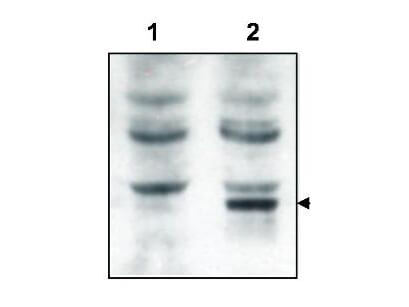Anti-Tamalin (RABBIT) Antibody
Tamalin Antibody
- SPECIFICATION
- CITATIONS
- PROTOCOLS
- BACKGROUND

| Host | Rabbit |
|---|---|
| Conjugate | Unconjugated |
| Target Species | Mouse |
| Reactivity | Human, Mouse |
| Clonality | Polyclonal |
Application
| WB, E, IP, I, LCI |
| Application Note | This affinity purified antibody has been tested for use in ELISA, western blotting, and immunoprecipitation. Specific conditions for reactivity should be optimized by the end user. Expect a band approximately 42 kDa in size corresponding to Tamalin protein by western blotting in the appropriate cell lysate or extract. |
| Physical State | Liquid (sterile filtered) |
| Buffer | 0.02 M Potassium Phosphate, 0.15 M Sodium Chloride, pH 7.2 |
| Immunogen | This affinity purified antibody was prepared from whole rabbit serum produced by repeated immunizations with a synthetic peptide corresponding to amino acids near the amino terminus of mouse Tamalin protein. |
| Preservative | 0.01% (w/v) Sodium Azide |
| Gene ID | 56149 |
|---|---|
| Other Names | 56149 |
| Purity | This affinity purified antibody is directed against mouse Tamalin protein. The product was affinity purified from monospecific antiserum by immunoaffinity chromatography. A BLAST analysis was used to suggest cross-reactivity with Tamalin protein from rat based on a 94% homology with the immunizing sequence. Reactivity against homologues from other sources is not known. |
| Storage Condition | Store vial at -20° C prior to opening. Aliquot contents and freeze at -20° C or below for extended storage. Avoid cycles of freezing and thawing. Centrifuge product if not completely clear after standing at room temperature. This product is stable for several weeks at 4° C as an undiluted liquid. Dilute only prior to immediate use. |
| Precautions Note | This product is for research use only and is not intended for therapeutic or diagnostic applications. |
| Name | Tamalin {ECO:0000303|PubMed:11850456} |
|---|---|
| Synonyms | Grasp |
| Function | Plays a role in intracellular trafficking and contributes to the macromolecular organization of group 1 metabotropic glutamate receptors (mGluRs) at synapses. |
| Cellular Location | Cytoplasm, perinuclear region {ECO:0000250|UniProtKB:Q8R4T5}. Cell membrane {ECO:0000250|UniProtKB:Q8R4T5}; Peripheral membrane protein {ECO:0000250|UniProtKB:Q8R4T5}; Cytoplasmic side {ECO:0000250|UniProtKB:Q8R4T5}. Postsynaptic cell membrane {ECO:0000250|UniProtKB:Q8R4T5} |
| Tissue Location | Highly expressed in brain, heart and lung, and to a lower extent in embryo, kidney and ovary. |

Thousands of laboratories across the world have published research that depended on the performance of antibodies from Abcepta to advance their research. Check out links to articles that cite our products in major peer-reviewed journals, organized by research category.
info@abcepta.com, and receive a free "I Love Antibodies" mug.
Provided below are standard protocols that you may find useful for product applications.
Background
This antibody is designed, produced, and validated as part of a collaboration between Rockland and the National Cancer Institute (NCI) and is suitable for Cancer, Immunology and Nuclear Signaling research. Tamalin, also named General receptor for phosphoinositides 1-associated scaffold protein (GRASP) is a PDZ (post-synaptic density protein/Drosophila disc large tumor suppressor/zo-1) domain-containing protein that interacts with group 1 metabotropic glutamate receptors (mGluRs). The PDZ domain-containing amino-terminal half of Tamalin binds directly to the class I PDZ-binding motif of group 1 mGluRs. The carboxyl-terminal half of Tamalin binds to cytohesins, which are guanine nucleotide exchange factors (GEFs) specific for the ADP-ribosylation factor (ARF) family of small GTP-binding proteins. Tamalin forms a protein complex with group 1 mGluRs at the post-synaptic site of specific neuronal cells and serves as a key scaffold protein that links a complex formation between mGluR1a and cytohesins. It is reported that Tamalin plays a key role in the association of group 1 mGluRs with the ARF-specific GEF proteins and contributes to intracellular trafficking and the macromolecular organization of group 1 mGluRs at synapses.
If you have used an Abcepta product and would like to share how it has performed, please click on the "Submit Review" button and provide the requested information. Our staff will examine and post your review and contact you if needed.
If you have any additional inquiries please email technical services at tech@abcepta.com.













 Foundational characteristics of cancer include proliferation, angiogenesis, migration, evasion of apoptosis, and cellular immortality. Find key markers for these cellular processes and antibodies to detect them.
Foundational characteristics of cancer include proliferation, angiogenesis, migration, evasion of apoptosis, and cellular immortality. Find key markers for these cellular processes and antibodies to detect them. The SUMOplot™ Analysis Program predicts and scores sumoylation sites in your protein. SUMOylation is a post-translational modification involved in various cellular processes, such as nuclear-cytosolic transport, transcriptional regulation, apoptosis, protein stability, response to stress, and progression through the cell cycle.
The SUMOplot™ Analysis Program predicts and scores sumoylation sites in your protein. SUMOylation is a post-translational modification involved in various cellular processes, such as nuclear-cytosolic transport, transcriptional regulation, apoptosis, protein stability, response to stress, and progression through the cell cycle. The Autophagy Receptor Motif Plotter predicts and scores autophagy receptor binding sites in your protein. Identifying proteins connected to this pathway is critical to understanding the role of autophagy in physiological as well as pathological processes such as development, differentiation, neurodegenerative diseases, stress, infection, and cancer.
The Autophagy Receptor Motif Plotter predicts and scores autophagy receptor binding sites in your protein. Identifying proteins connected to this pathway is critical to understanding the role of autophagy in physiological as well as pathological processes such as development, differentiation, neurodegenerative diseases, stress, infection, and cancer.


